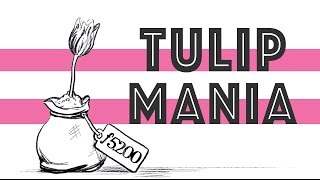(单词翻译:单击)
How much would you pay for a bouquet of tulips?
你愿意出多少钱买一束郁金香?
A few dollars? A hundred dollars?
几美元?一百美元?
How about a million dollars? Probably not.
如果是一百万美元呢?应该不会买吧。
Well, how much would you pay for this house, or partial ownership of a website that sells pet supplies?
你愿意出多少钱买这栋房子,或者是售卖宠物用品网站的部分股权?
At different points in time, tulips, real estate and stock in pets.com have all sold for much more than they were worth.
在历史上某些时间点,郁金香、房地产、pets.com网站的股票都卖到了比它自身价值更高的价格。
In each instance, the price rose and rose and then abruptly plummeted.
在每个实例中,价格不断上涨,然后突然剧烈下跌。
Economists call this a bubble.
经济学家称之为泡沫。
So what is exactly is going on with a bubble?
那么,到底发生了什么呢?
Well, let's start with the tulips to get a better idea.
让我们从郁金香的例子开始解读。
The 17th century saw the Netherlands enter the Dutch golden age.
在17世纪,荷兰进入了经济发展黄金时期。
By the 1630s, Amsterdam was an important port and commercial center.
在17世纪30年代,阿姆斯特丹成为重要的贸易港口和金融中心。
Dutch ships imported spices from Asia in huge quantities to earn profits in Europe.
荷兰商船从亚洲大量进口香料,在欧洲赚取利润。
So Amsterdam was brimming with wealthy, skilled merchants and traders
阿姆斯特丹充满了富裕且经商有道的商人和交易员,
who displayed their prosperity by living in mansions surrounded by flower gardens.
他们展现富有的方式是居住在豪华宅邸,宅邸周围是种满鲜花的花园。
And there was one flower in particularly high demand: the tulip.
某一种花有特别高的需求量:郁金香。
The tulip was brought to Europe on trading vessels that sailed from the East.
郁金香是货船从东方带来欧洲的品种。
Because of this, it was considered an exotic flower that was also difficult to grow,
因此被称为异域风情的花,而且郁金香很难种植。
since it could take years for a single tulip to bloom.
一枝郁金香盛开需要好多年的时间。
During the 1630s, an outbreak of tulip breaking virus
在17世纪30年代,爆发的郁金香色彩变异病毒
made select flowers even more beautiful by lining petals with multicolor, flame-like streaks.
让某些品种的郁金香愈发美丽,因为病毒让画板有了多种颜色,犹如火焰般的纹路。
A tulip like this was scarcer than a normal tulip
这样的郁金香比普通品种更加稀少,
and as a result, prices for these flowers started to rise, and with them, the tulip's popularity.
因此,这种郁金香的花朵的价格开始上涨,与此同时,郁金香开始风靡起来。

It wasn't long before the tulip became a nationwide sensation and tulip mania was born.
很快就到了举国上下为之轰动,郁金香热开始了。
A mania occurs when there is an upward movement of price
这场狂热伴随着另一种现象,价格的上涨,
combined with a willingness to pay large sums of money for something valued much lower in intrinsic value.
人们乐意出很高的价格买一些价值很低的东西。
A recent example of this is the dot-com mania of the 1990s.
一个最近的例子就是20世纪90年代对网络公司的风靡。
Stocks in new, exciting websites were like the tulips of the 17th century. Everybody wanted some.
新潮的网络公司的股票犹如17世纪的郁金香花。每个人都想要。
The more people who wanted the tulip, the higher the price could go.
越多人想要购买郁金香,其价格也就会越来越高。
At one point, a single tulip bulb sold for more than ten times the annual salary of a skilled craftsman.
在某个时刻,一支郁金香的价格是熟练工匠年薪的10倍。
In the stock market, the price of stock is based on the supply and demand of investors.
在股票市场,股票价格由投资者的供需来决定。
Stock prices tend to rise when it seems like a company will earn more in the future.
当这个公司未来盈利的前景较为乐观,股票价格会上涨。
Investors might then buy more of the stock, raising the prices even further due to an increased demand.
投资者就会买购买更多的股票,因为需求量的增加,股票价格就会更高。
This can result in a feedback loop where investors get caught up in the hype
这会形成“反馈回路”,投资者们为之兴奋疯狂,
and ultimately drive prices far above intrinsic value, creating a bubble.
最终让价格远远高于其内在价值,创造了一个泡沫。
All that is needed for a mania to end and for a bubble to burst
狂热的结束以及泡沫的破裂
is the collective realization that the price of the stock, or a tulip, far exceeds its worth.
会发生在人们集体意识到股票的价格,或是郁金香的价格,远远高于它的价值。
That's what happened with both manias. Suddenly the demand ended.
对股票和郁金香的疯狂就是这样终结的。突然间需求不再。
Prices were pushed to staggering lows, and pop!
价格跌到令人惊讶的低点,然后,嘭!
The bubbles burst, and the market crashed.
泡泡破了,市场垮了。
Today, scholars work long and hard trying to predict what causes a bubble and how to avoid them.
今天,学者们花费长时间的努力来试图预测泡沫是如何产生的,以及如何预防泡沫产生。
Tulip mania is an effective illustration of the underlying principles at work in a bubble
郁金香狂热就是个来阐述泡沫的产生以及破灭的很好的例子,
and can help us understand more recent examples like the real estate bubble of the late 2000s.
能够帮助我们理解现代的例子,像是20世纪末的房地产泡沫。
The economy will continue to go through phases of booms and busts.
经济会持续不断经历着繁荣和萧条。
So while we wait for the next mania to start, and the next bubble to burst,
当我们等待下一场狂热开始,下一个泡沫破裂的时候,
treat yourself to a bouquet of tulips and enjoy the fact that you didn't have to pay an arm and a leg for them.
为自己买一束郁金香花吧,享受这个无需为它们花很高的价钱的事实吧。


